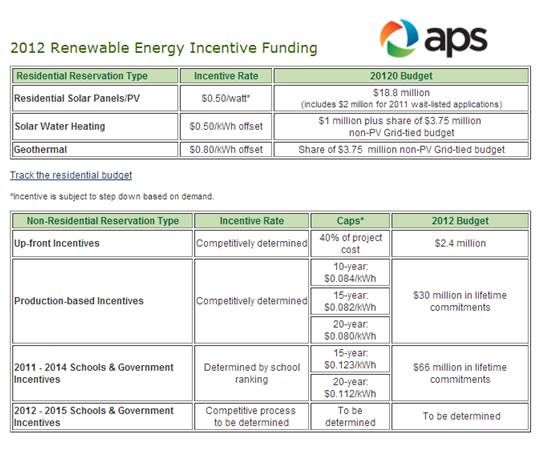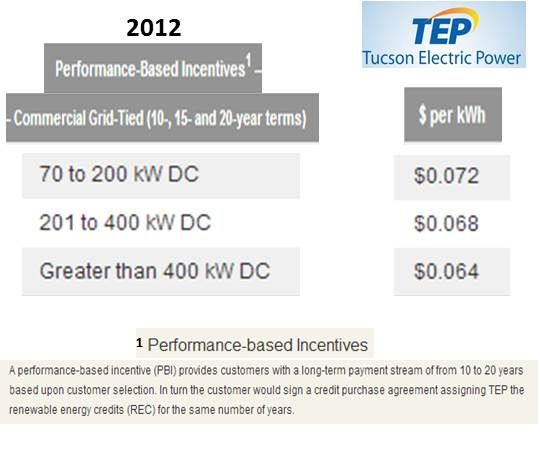The Arizona Corporation Commission (ACC) has eliminated the performance-based incentives (PBIs) provided to commercial solar system buyers by the state’s two investor-owned utilities (IOUs). It also drastically reduced the upfront incentives (UFIs) provided by the IOUs to residential solar system buyers.
Arizona Public Service (APS) was scheduled to reduce its PBIs for commercial systems to $20.8 million for 2013. Tucson Electric Power (TEP) was scheduled to go to $10.5 million. Both will now go to zero.
In addition, a scheduled $400,000 in APS UFIs were cut to $100,000, and a scheduled $1.7 million in TEP UFIs were cut completely.
The APS residential UFIs were scheduled to go to $6.96 million. That was cut to $2.65 million. TEP’s residential UFIs were cut from $1.46 million to $744,000.
The $38.3 million one-day hit to Arizona’s photovoltaic (PV) solar industry came unexpectedly on the last day of a seven-month public premium re-evaluation process and caught Arizona’s solar advocates completely unprepared and defenseless.
The UFIs were paid at the rate of $0.10 per watt. The PBIs were based on competitive solicitations, had been about $0.06 to $0.07 per kilowatt-hour and were expected, due to increasingly competitive solar costs, to fall to about $0.05 to $0.06 per kilowatt-hour this year.
“As the Arizona incentives have been slowly reduced, the industry has kept up,” explained SolarCity (NASDAQ:SCTY) Governmental Affairs Director Meghan Nutting. “Ratepayers have invested in the industry to a point where we are almost without a need for incentives. But a sudden and complete elimination of all incentives that cuts the commercial solar industry off at the knees means we will have to start over.”
The ACC decision, she added, means “people are going to lose their jobs in the sunniest state in the country in an industry that Arizona has depended on through the recession and should dominate.”

Source: GTM Research’s Q3 2012 U.S. Solar Market Insight
The entirely Republican ACC commissioners’ rationale for the cuts, Nutting said, was that they will reduce the Renewable Energy Standard and Tariff (REST) premium added to Arizona ratepayers’ utility bills to fund solar.
The REST premium was established by the ACC in 2007 and is capped at $4.00 per month. Calculations by Arizona solar advocates concluded the PBI cuts will save APS ratepayers no more than $0.02 to $0.06 per month.
Solar Energy Industries Association (SEIA) VP Carrie Cullen Hitt called the ACC action “a step backwards for Arizona's longstanding commitment to economic development, free markets and expansion of clean energy resources” and “particularly troubling at a time when Arizona faces challenges including water usage and shuttering of coal facilities.”
“This effectively kills the commercial solar market in Arizona,” Mainstream Energy/REC Solar Legislative Director Ben Higgins said. “We figure for a 1-megawatt system, we will employ 30 to 35 workers for three to four months,” Higgins said. “We have multiple-megawatt and larger systems in Arizona that will now not move forward.”
Other Arizona solar industry insiders also predicted job losses and layoffs. Wilson Electric Solar Division Manager Mark Holohan predicted “layoffs, shrinkage and less business. North of 90 percent of our commercial business has come from the APS and TEP commercial incentives. I will be surprised if we can get a fifth of that volume without incentives.”
“This will have a negative impact on jobs in Arizona,” said Arizona Solar Energy Industries Association (AriSEIA) Executive Director Michael Neary after an AriSEIA meeting to discuss the ACC decision. “There is the very real possibility of layoffs in the industry.”
One national installer told GTM that it might have to lay off as much as 40 percent of its Arizona workforce.
“My company is open for business and we continue to believe solar is a good opportunity,” said Technicians for Sustainability owner Kevin Koch. “But without the incentives that helped fund the 1.5 megawatts of commercial-scale nonprofit projects we built last year and the 800 kilowatts we will finish this spring with last year’s incentives, there may be no more such projects.”
Koch already had to let go five of his 50 employees, and if the effort he is now determined to make to find other solar opportunities doesn’t pay off, he said, “we could be a ten-person company by the fall. Losing that human capital would be a major loss to solar.”
Higgins and Nutting noted that the ACC’s process was problematic. After a seven-month procedure that began with public proposals from APS and TEP and included extensive public comment and private meetings with commissioners and their staffs, solar advocates went into the ACC meeting expecting no change to the proposed incentive schedule. But they were met with an unannounced amendment that all but eliminated them.
The commissioners’ discussion “took a matter of minutes,” Higgins said. “They made repeated reference to piles of letters from angry ratepayers about increasing electric bills,” he said. “But there was no analysis of what the impact would be from the incentive cuts and no cost-benefit test. It is highly unlikely any ratepayer is ever going to notice a difference on their bills from this.”
The commissioners rejected solar advocates’ arguments that the incentive cuts would harm the industry, noting that there has been industry despair at previous cuts that did not turn into economic harm. Attempts to contact commissioners for further comment got no response.
“The Arizona solar industry has dramatically reduced its dependence on incentives, but this is too much, too soon," Nutting said. "Especially given that utility projects are costing ratepayers considerably more than solar installed in the competitive market, this is a shortsighted decision.”





